This module is broadly based on the Adventist Accrediting Association Accreditation Handbook (2019) and it emphasizes content for team members from the North American Division (NAD) serving in accreditation visits to NAD colleges and universities, particularly for AAA regular accreditation visits.
This Training Module will briefly describe the philosophy of Adventist education the church accreditation system as well as its governance and its functioning. It will also outline the process that visiting team members will follow from the time they accept the invitation to serve until the end of the visit.
At the end of the training module, you will be prepared to:
- Make sound judgments about the functioning of institutions visited under the AAA standards.
- Conduct an effective review of the institutional Self-Study.
- Write a quality team report based on data from various sources that reflects fulfillment of prior recommendations and the issuance of new commendations, recommendations, and suggestions.
- Collaborate in the decision-making process that leads to an overall recommendation for the next accreditation visited institution.
1. Philosophy of Seventh-day Adventist Education and Rationale for Adventist Accreditation
The Seventh-day Adventist philosophy of education[1]is Christ-centered. Adventists believe that, under the guidance of the Holy Spirit, God’s character and purposes can be understood as revealed in the Bible, in Jesus Christ, and in nature. The distinctive characteristics of Adventist education— derived from the Bible and the writings of Ellen G. White—point to the redemptive aim of true education: to restore human beings into the image of their Maker.
Adventist education imparts more than academic knowledge. It fosters a balanced development of the whole person—spiritually, intellectually, physically, and socially. Its time dimensions span eternity. It seeks to develop a life of faith in God and respect for the dignity of all human beings; to build character akin to that of the Creator; to nurture thinkers rather than mere reflectors of others’ thoughts; to promote loving service rather than selfish ambition; to ensure maximum development of each individual’s potential; and to embrace all that is true, good, and beautiful.
In order to attain the goals and objectives of education, the educational process must ensure quality. This is where accreditation plays its fundamental role. The Adventist Accrediting Association (AAA) is the recognized accrediting body commissioned by the Seventh-day Adventist Church to carry out the accrediting process for Adventist institutions of higher education around the world.
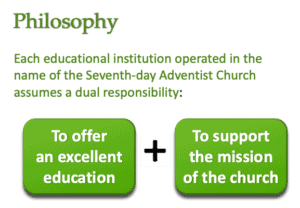
AAA supports the right of each institution to pursue its educational mission under the guidance of a governing board elected by its constituency; the right of the faculty to teach, carry out, and publish research; and the right of students to learn and to develop their God-given talents. However, the exercise of these rights must not interfere with the institution’s obligation to provide quality education within the context of the beliefs, mission, educational philosophy, and practices of the Seventh-day Adventist Church.
Therefore, accreditation teams will seek to achieve the following objectives:
- To evaluate, based on the Self-Studydocument and an onsite visit, the overall status of the Seventh-day Adventist educational institution.
- To assess the degree to which the institution fulfills the Seventh-day Adventist philosophy of education in forming the character and developing the talents of students.
- To determine if the degree programs offered by the institution are comparable in content and quality to those offered by similar Seventh-day Adventist educational institutions.
- To provide guidance to the administration and the institutional board on ways in which the institution may strengthen its operation and better achieve its educational and spiritual objectives and its overall mission.
[1]Based on the Statement of Educational Philosophy (2001), and George Knight issue of JAE on the topic.
2. The AAA Board and the IBE/IBMTE Boards
Adventist accreditation is governed by three boards with global scope. These boards are the Adventist Accrediting Association (AAA) Board, the International Board of Education (IBE), and the International Board of Ministerial and Theological Education (IBMTE). They meet twice a year: April and October. Accreditation recommendations and other statements issued by visiting teams are actually recommendations to the corresponding board, as the boards are the only bodies to act.
The Adventist Accrediting Association (AAA)is the accrediting authority for all tertiary and graduate programs and institutions owned by the Seventh-day Adventist church entities (Elementary and secondary levels are delegated to Commissions on Accreditation of the corresponding divisions.) The AAA Boardgoverns the accrediting association of the Adventist church. To be recognized as an official Adventist educational institution, each school, college, and university must have AAA accreditation.
The AAA Board is chaired by the General Conference (GC) education director. The secretary is one of the associate directors of the GC education department. The board is made up of all division education directors, representatives from SDA higher education, including board chairs, presidents, academic deans, registrars, finance officers, and deans of education, as well as superintendents and other individuals with international experience in Adventist education.
A regular function of the AAA Board is to approve and re-approve institutional accreditation based on visiting committee recommendations. According to the denominational policies, only those institutions holding current denominational accreditation are eligible to receive church subsidies.
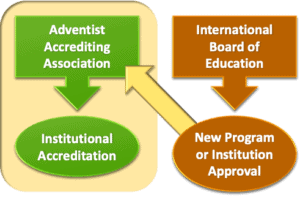
The International Board of Education (IBE)is the primary vehicle through which the GC education department coordinates Seventh-day Adventist education throughout the world. It is chaired by a GC vice president with the GC education director as executive secretary. The board has wise representation, including GC leaders, Division presidents, college/university board chairs, institutional presidents, faculty, Division education directors, and others.
One of the principal tasks of the IBE Boardis to review and approve the establishment or discontinuance of tertiary-level institutions and programs as well as define strategic priorities of Adventist education worldwide. When a new program (or new institution) is approved, it becomes part of the AAA list and subject to visits when the time of accreditation renewal is due.
The International Board of Ministerial and Theological Education (IBMTE)provides guidance and standards to the professional training that church-supported institutions offer to pastors, chaplains, Bible teachers and other denominational employees involved in ministerial and religious formation. This board is chaired by the GC president or designee with the GC education director as executive secretary. Its membership includes several GC officers and directors of relevant departments, religion faculty, religion chairs, seminary deans, and other individuals experienced and active in ministerial and theological education.
This board recommends to AAA the criteria for the accreditation of seminaries, schools, and departments offering programs to prepare denominational employees involved in ministerial and religious formation. It also cooperates with AAA in conducting accreditation visits to seminaries, schools, and departments offering ministerial and theological preparation.
In addition to the IBMTE, each world division has a board of ministerial and theological education to oversee, supervise, guide, and coordinate the preparation of pastors and other denominational employees involved in ministerial and religious formation in their corresponding geographic areas.
3. Relation of AAA Accreditation to Regional Accreditation
It is essential that Adventist institutions operate within the mission of the Seventh-day Adventist church, clearly reflecting Adventist identity and ethos. Regional accreditation is also important to the ongoing health and credibility of colleges and universities and it should be pursued, while affirming the calling to be true to the mission of the church.
Insomuch as the reason an Adventist institution exists is to fulfill the gospel commission by building Adventist intellectual capacity for the church and society, AAA accreditation seeks to ensure that each institution continues to uphold the mission of the church in the context of high-quality academic programs. This is evidenced by:
- Institutional mission statements that harmonize with the overall mission of the Church.
- Administration, faculty, and staff who support the beliefs, behaviors, and values of the Church.
- Policies and procedures of the institution that uphold the mission of the Church and institution.
- Academic and student life programs that are consistent with the mission of the church and institution.
- Board, leadership, faculty, and students who embrace the role and function of AAA accreditation.
- An education system that offers a comprehensive, whole-person, Seventh-day Adventist education, which also contributes toward national goals and aspirations of the country in which it functions.
- A unique Seventh-day Adventist identity and purpose that is evidenced through quality assurance mechanisms.
4. Nature of the Regular Visit—Form B
This training guide focuses on the accreditation of Form B institutions, which contains a more focused accreditation set of criteria in contrast with the original, and widely used worldwide, Form A. Assuming that a successful regional accreditation status looks closely at more technical and operational functions of the institution, Form B standards and criteria are focused on the more unique and missional aspects of Adventist education.
Types of visits
The regular accreditation visit comes after a number of years of ongoing accreditation and it is based on an extensive self-evaluation conducted by the college/university to be visited. The conclusions of the self-evaluation will be reflected in a Self-Studydocument provided by the college or university to the team no less than one month prior to the visit.
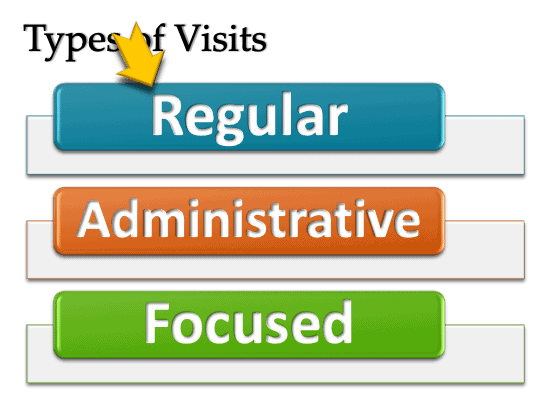
An administrative visit is performed by a small team (normally the chair of the previous regular visit plus one representative each from GC and NAD). The administrative visit offers the opportunity to formally interface with the college/university after five years have passed since its previous regular visit, but without expecting the institution to prepare a full Self-Study. If the team is satisfied with the progress made during that time, it may recommend to AAA an extension of five additional years or less, matching the term in its totality to the number of years granted by the regional/government accreditation body.
A focused visit is made to a college/university during the accreditation term to respond to an identified area of concern. A team of specialists on such area will be focusing only on matters pertaining the focused area (e.g., financial, Adventist identity, or other).
Regular Visit Committee Selection
The Education Department at the General Conference of Seventh-day Adventists (GC EDU) and the Education Department at the respective Division, represented by the GC EDU liaison and the Division director for higher education jointly draft a roster of team members. This list receives the input of the college/university president to be visited. Once this consultation has taken place, prospective individuals are invited to join the visiting team. In a Form B visit, committees may be chaired by a college/university president and a vice president for academic administration (VPAA) may serve as secretary.
The individuals recommended for an accreditation team will be experienced in various areas of administration and education, congruent with the profile of the college/university to be visited. It is advised that a minimum of one team member be invited from a higher education institution from outside the given Division and that at least one team member, while a member of the Seventh-day Adventist Church in regular standing, not be a denominational employee. The GC EDU liaison and/or the Division director for higher education will contact the members of the committee and obtain the approval of the employing organization for their involvement in the visit.
Financial Arrangements
Unlike most accrediting organizations, AAA does not charge colleges/universities an accreditation fee. In order to cover expenses, travel and accommodation expenses of visiting members, who are volunteers, are shared in the following manner: The transportation costs of any team member employed by the Seventh-day Adventist church is the responsibility of the employing organization. The corresponding Division is usually responsible for travel expenses of any individual not employed within the church system. The GC EDU liaison may negotiate alternative funding arrangements for individuals traveling from other divisions where travel expenses are excessive. The college/university to be visited is expected to provide room and board in addition to local transportation to the visiting team members.
The visiting committee as a whole will own and sign the full report. However, each member will be assigned to draft one or more areas with their corresponding criteria for review (CFR). The assignment will be done around the time when the college/university to be visited submits the Self-Study.
5. The Institutional Self-Study—Form B
About one year prior to the visit, and with ample input from across the institution, the college/university will start the preparation of the Self-Studydocument. This document, due to the visiting members one month before the visit, is divided into three Sections:
Self-Study Section A. This section responds to the recommendations from the latest accreditation visit, stating whether each recommendation has been implemented, how it was accomplished, and providing the evidence of its fulfillment. Likewise, a partially-fulfilled recommendation is identified as such, indicating the elements not yet fulfilled. And for not-fulfilled recommendations, such fact should be identified with the reason/s for the lack of fulfillment.
A partially fulfilled or unfulfilled recommendation will typically result in a transfer of the recommendation to the new site visit report, although the wording of the recommendation may be adjusted.
team assessing whether these reasons are valid or not, in determining whether the recommendation (or parts of it) will carry forward.
- Expectation for team members:Each team member is expected to make a decision on the fulfillment of each recommendation under his/her area. The team will review this decision and state the percentage of recommendations that have been met.When an unmet (or partially unmet) recommendation is claimed as met by the institution and its fulfilment is unclear, the team will assess whether the reasons are valid or not and will determine whether the recommendation (or parts of it) will carry forward.
Self-Study Section B. It provides evidence in response to each of the seven areas with their corresponding Criteria for Review (CFRs). See the Accreditation Handbookfor a full listing of CFRs and the preferred evidences that serve to document compliance. While the Self-Studyand the site visit focus on outcomes, it is acknowledged that some of the most important outcomes, such as spiritual commitment and ethical behavior evidenced throughout the life of a graduate, are difficult to measure, and, furthermore, difficult to attribute to a specific part of the student’s educational experience due to the influence of intervening variables. Consequently, inputs and processes are at times utilized as proxies for such outcomes.
- Expectation for team members:Each team member is expected to assess the adherence of the college/university to each CFR of the area (or areas) assigned to him or her. Once initial findings are confirmed via interviews or other sources (e.g., observation, documents), commendations, recommendations, and suggestions will typically be proposed to the visiting committee for final inclusion in the report.
Self-Study Section C. This section showcases an aspect of the work of the college/university (initiated or continued during the years of the current accreditation period) that highlights the institution’s commitment to the mission of the Seventh-day Adventist Church and/or the philosophy of Adventist education, particularly as it relates to student learning.
- Expectation for team members:Although this section will be of great general interest to understand the visited institution and underscore its best practices, there is no evaluative expectation on the part of the team, although this initiative may be reflected in one or more commendations in appropriate sections of the team report.
The template given to each team member will reflect the above expectations.
Preparation for the Visit
One month prior to the visit, the host college/university will submit the completed Self-Studydocument to the GC EDU liaison, who will distribute it to the other members of the visiting committee.
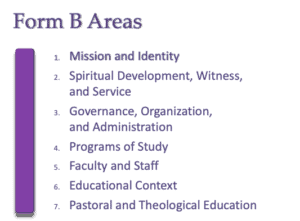
The distribution of writing tasks will also be done about this time. Typically, one area will be assigned to each committee member. On occasion, particularly with small colleges/universities, members may be assigned more than one area.
The GC EDU liaison and the Division director for HE, in consultation with the college/university, will prepare a schedule for the regular visit, normally three full days. The schedule will include the following:
- An orientation meeting where the material learned in the training module will be reviewed and the committee will agree on procedures.
- An initial meeting between the college/university administrative team and the visiting committee to discuss the institution’s formal responses to the recommendations of the previous visit, as well as major developments, achievements, trends, and challenges since the last visit.
- Group interviews with students, faculty, staff, alumni, and board representatives, including its chair.
- Individual interviews arranged as needed between selected members of the committee and key individual/small groups representing administration, academic departments, pastor and/or chaplain, services (dormitories, library, computer center, laboratories, cafeteria, health clinic, industries, maintenance, etc.), and student leaders.
- A guided tour of selected facilities.
- Preparation of the written report, first individually, and then as a committee with the input from all members.
- Exit report, providing highlights from the written report.
Expectation for team member. Prior to arrival on campus, it will be the responsibility of the committee members to read the documents sent to them in advance of the visit and to inform the designated individual at the institution of the time and place of their arrival, so that arrangements for their transportation and accommodation can be made.
7. Report Preparation
The most important product of the onsite visit is the visiting committee report—the regular visit report. It will be fully drafted by the time of the exit report. Shortly thereafter, institutional administration will receive a copy of the draft report to allow for corrections of errors of fact by the college/university. Then the final report will be submitted to the AAA Board agenda for the next board meeting.
The secretary will collate the full report, but he or she requires support from the college/university and from each member of the visiting committee. The following are specific expectations from each team member:
- Write an introduction (Findings) to your area—about 2-3 paragraphs
- Determine whether each previous recommendation has been fulfilled, is being fulfilled, or has not yet begun to be implemented. For those recommendations which are partially fulfilled, describe what has been completed and what still remains to be done.
- Write new commendations
- Write new recommendations, identifying which ones are major recommendations by preceding these with a single asterisk (*). [Note: A major recommendation is one which carries an exceptional level of importance and/or urgency. As there are to be no more than 10-12 major recommendations overall, there should be only 1-2 major recommendations per Area.]
- Carry over in the Recommendations section any prior recommendations which are partially fulfilled or unfulfilled, and which are still relevant [Note: Prior recommendations may be reworded for clarity. Only the unfulfilled portion of a partially fulfilled recommendation should be carried forward. All prior recommendations are preceded by a double asterisk (**). Any prior recommendation which be deemed to be no longer relevant should be discussed with the full team, in order to arrive at a consensus that it should be dropped from the report.]
- Write new suggestions
- Send all of the above to the team secretary by the due time—it will be indicated in the schedule, normally the evening before the last day.
Definitions of commendation, recommendation, and suggestion follow under section “Selecting and writing commendations and recommendations” below. Committee members will be supplied with a template to facilitate their writing.
A typical AAA regular visit report contains the following sections:
Introduction. A summary of the report, including the name of the institution visited, the dates of the visit, the members and affiliation of the visiting committee, the text of the final accreditation recommendation, and the signature page.
- Responsible: Team Secretary.
Background to Institution and Visit. A brief historical and geographical background to the college/university, profile, listing of degree programs, enrollment statistics and trends, faculty statistics, list of other accreditations, list of administrators at the time of the visit, circumstances of the visit, documents examined, and a summary of the state of fulfillment of previous recommendations.
- Responsible: The college/university provides it and the Team Secretary inserts it in the report.
The Areas. The report lists the seven areas (sometimes called standards) in turn. Under each of the areas, the following headings are included:
- Observations and findings
- Prior recommendations
3. Commendations
4. Recommendations, including identification, with an asterisk (*) for major recommendations and a double asterisk (**) for prior recommendations - Suggestions
- Responsible: Each team member as assigned will write observations and findings, a statement of fulfillment of prior recommendations, commendations, recommendations resulting from the visit (both new recommendations and any recommendations carried forward), and suggestions.
The document closes with a statement of appreciation.
8. Types of Recommendations
Every report prepared onsite contains three types of recommendations according to their significance:
Prior recommendations. As stated in the section Report Preparationabove, there might be prior recommendations which are partially fulfilled or unfulfilled, and which are still relevant.
Regular Recommendations. These are the majority of the recommendations contained in the report and refer to institutional operations that need improvement. They are distributed across the standards. While the AAA advises that there should be no more than 10-12 major recommendations overall, the typical number of recommendations in a given Area at a particular institution is a matter which will be discussed and decided upon by the team, given that this can vary depending upon the particular institutional conditions.
Major Recommendations. These are the recommendations with the greatest significance that may affect the stability and/or Adventist ethos of the institution. These are to receive immediate attention by the college/university. Major recommendations will be asterisked (*) where they are found throughout the report. The number of total major recommendations should normally be one to two per area on average.
The Overall or Accreditation Recommendation. This recommendation reflects the term of accreditation in number of years and with particular conditions. It is a recommendedstatement from the visiting team to the AAA Board, which ultimately will make the final determination. The overall recommendation is drafted toward the end of the visit, based on the observations made and taking into consideration the options available. (See ‘The Overall Recommendation’ heading below) and Appendix C of the Accreditation Handbook). The committee will arrive at its final recommendation by either majority vote or consensus agreement. The overall recommendation is confidential until the time the AAA Board acts upon it. The team chair and members are not at liberty to share this recommendation outside of the visiting team.
In addition, the committee may insert suggestions,which are written in the same manner as regular recommendations and invite the college of university to implement them if they consider it fit, but for which the institution will not have to render accountability.
9. Selecting and Writing Commendations and Recommendations
Commendations and recommendations are a central part of the report to be drafted during the onsite visit. It is therefore of utmost importance to use relevant and clear language, useful to the college/university to improve its quality and Adventist identity and ethos.
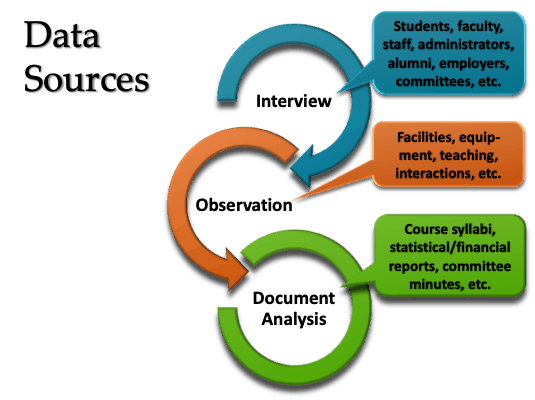
These are guidelines to write commendations, recommendations, and suggestions:
- Commendations, recommendations, and suggestions should be based on the Self-Study documentation, supplemented by interviews, observation and other institutional documentation.
- Commendations are given for tasks performed in an above-average or superior manner, not just for performing tasks in a regular fashion or for fulfilling prior recommendations.
- Recommendations represent institutional deficiencies against the Criteria for Review (CFRs) that the committee considers in need of improvement.
- Each commendation or recommendation must be based on a minimum of two sources: either the Self-Studydocument or other institutional documents, personal observation, or an interview with a board member, administrator, faculty, staff, students, or alumni. This crosscheck and verification of sources must be identified for each commendation and recommendation.
- Commendations or recommendations should be addressed to a specific group, department, or unit in the institution—never to individuals by name.
- Recommendations should be concise, specific and measurable (i.e., how will an observer know if a specific recommendation has been fulfilled) when possible, and should focus on outcomes, rather than on the process by which the outcome is achieved.
- Recommendations should focus on major issues and should be limited to a number reasonable for the institution to manage in the period before the next full evaluation visit.
Sample commendations and recommendations follow, with an explanation of how these can be used as a pattern for team members.
Commendations
The visiting committee commends:
- The administration, for their high level of positive communication with the local church community, which has resulted in an elevated regard for the institution by members of the local churches (Self-Study, p. 32; interviews with board representatives).
- The administration, faculty, staff and students, for their active involvement in the development of a spiritual master-plan that is already making an appreciable difference to the spiritual programming and ethos of the campus (Self-Study, pp. 17, 47; institutional strategic plan; interviews with faculty and staff; student survey).
Notes:
- Writers should state to who the commendation is given. Individual names, however, should not be given—only titles, or groups of individuals.
- Commendations should state clearly what is being commended with as much precision as possible. This should include not only what is being done, but also the effect—in the second sample commendation, the commendation is for “the active development of a spiritual master-plan,” but the next part of the sentence helps explain why that is so important—“that is already making an appreciable difference to the spiritual programming and ethos of the campus.”
- A writer should give the source(s) of information that led to the conclusion. Where there are specific references to paginated documents, page numbers should be identified. However, if information came from an interview, the name(s) of the individual(s) should not be identified. A minimum of two sources should be provided for each commendation and recommendation.
Recommendations
The visiting committee (or team) recommends:
- That the administration and the office of the chaplain review the opportunities of spiritual growth offered on campus incorporating input from student of all levels (from sophomore to graduate) and academic majors (interviews with students; Self-Study, p. 35).
- That the administration implement a plan of community service opportunities developed jointly with the local churches (interviews with administrators and students; Self-Study, p. 12).
Notes:
- Writers should identify clearly to whom the recommendation is directed—in the above examples, to the administration and to the Academic Committee. The recommendations can be to an individual (mentioned only by title, e.g. President), a committee, or a group of individuals.
- If a recommendation is already in the plans of an institution, this should be identified in what is written—e.g., “That the Academic Committee enact its plans…”
- All recommendations should be doable and measurable. The institution needs to report completion of the recommendation and the next accrediting team needs to confirm that it has been met.
- The sources of recommendations should be referenced in as much detail as possible—e.g. audited financial statement, 2018-19.
- Each team member should consider which of the recommendations will be suggested to their colleagues as major and noted with an asterisk (*). In the samples given above, the first would likely be considered a major recommendation because it impacts the financial stability of the institution. In general, major recommendations will be those that significantly impact the college/university and are most essential to its continuous quality and to the embodiment of the Seventh‐day Adventist ethos.
Suggestions and Other Comments
Suggestions are ideas or processes that the visiting committee believes would be desirable or helpful for the college/university to implement but are not a necessity and therefore do not reach the level of recommendation. The college/university does not need to render an account for the implementation of suggestions.
Suggestions are placed at the end of the commendations and recommendations under the relevant area, and are introduced by following the same pattern, i.e., The visiting team suggests that:
At times, comments are placed below a recommendation when the team faces a particularly complex or sensitive situation and considers that the context of a recommendation needs to be carefully explained. Alternatively, the comment can be added to the Observations and Findings that serves as an introduction to the corresponding area.
Lastly, there may be times when the visiting committee sees the need of inserting “conditions” because of serious concerns regarding an aspect of the college/university in need of immediate attention. Conditions are best included in the overall recommendation, specifying the issue and the timeframe to attend it.
10. The Overall Recommendation
The accreditation recommendation, also called overall recommendation or final recommendation, states whether an institution should be accredited/reaccredited, and, if so, for what term and under what conditions. This is a recommendation to the AAA Board, and it is to remain confidential until the AAA Board has voted it, as the AAA Board may modify the recommendation. In deciding on the accreditation recommendation, the team will consider the options outlined below. For a more detailed explanation of all possible tiers, see the Accreditation Handbook, pp. II-7 to II-10.
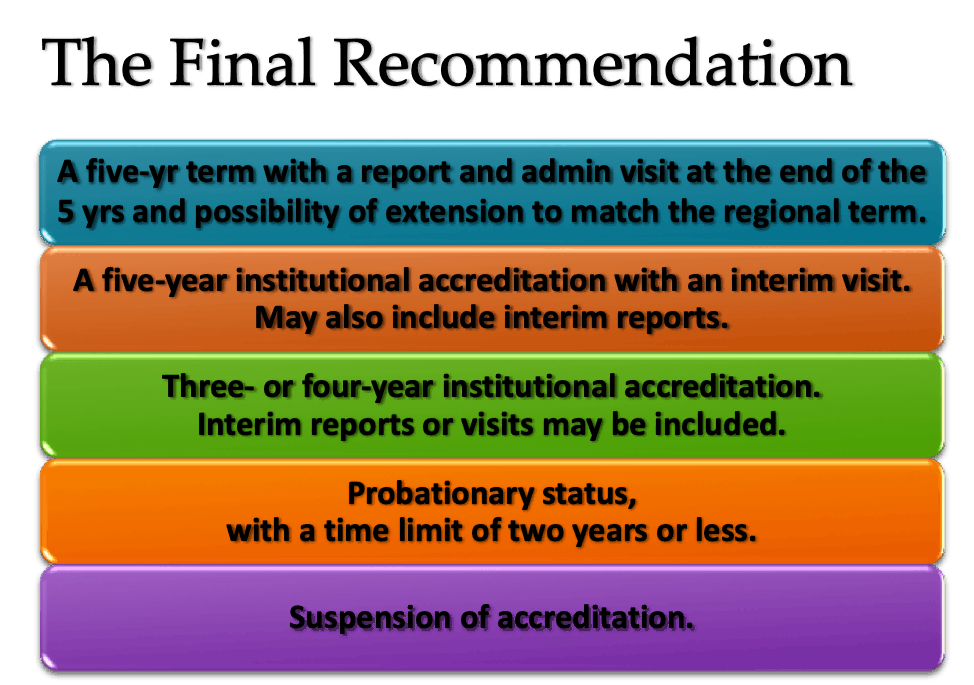
- A five-year institutional accreditation with no interim visit. [This is the highest tier for Form A institutions, and it may be also applicable to Form B, albeit very rarely]. It implies that a regular visit must take place after 5 years.
- A five-year term of institutional accreditation, with a report and administrative review visit at the end of that period, with the possibility of extension of the term to the duration of the regional or government term of accreditation. Interim reports may be requested. This option is typically for an institution that (a) has a strong track record of success in external accreditations; (b) has fulfilled or satisfactorily addressed all recommendations from the prior AAA visit, having successfully resolved persistent issues and concerns identified in prior AAA reports; (c) shows strength in each Area of its operation; (d) has submitted an acceptable Self-Studyat the designated time; (e) presents evidence that all programs offered have been approved by the IBE/IBMTE; and (f) presents no major circumstance that would negatively impact its mission, its Seventh-day Adventist focus or identity, or the financial or administrative well-being of the institution. (Option valid only for Form B institutions.)At the time of the administrative review visit, the team will expect to find that the institution has: (a) met the major recommendations of the previous visiting committee, (b) made significant progress toward meeting all other AAA recommendations, and (c) evidenced satisfactory progress in addressing the relevant issues raised by the regional accrediting or governmental review process. Only if these criteria are met, may the visiting committee recommend, and the AAA grant, an extension of the accreditation term that will match the number of years of the term granted by the regional or governmental agency. If these requirements have not been met, the visiting committee shall recommend, and the AAA may grant, a one-year extension of accreditation to the institution to allow it to prepare a Self-Studyand be ready for a full accreditation visit at the end of the one-year extension.
- A five-year institutional accreditation with an interim visit. Interim reports may be requested. This option is typically for an institution that (a) has fulfilled or satisfactorily addressed all recommendations from the prior AAA visit, having successfully resolved persistent issues and concerns identified in prior AAA reports; (b) has submitted an acceptable Self-Studyat the designated time; and (c) presents evidence that all programs offered have been approved by the IBE/IBMTE. Nevertheless, the institution shows weaknesses in one or more Areas of its operation; or is experiencing or will experience in the near future important circumstances in its administration, finances, status, programs, or size which could negatively impact the institutional mission, or its Seventh-day Adventist focus or identity. These specific issues will be identified in major recommendations.At the time of the interim visit, the team will expect that the institution has fulfilled or made substantial progress in fulfilling all the major and other recommendations. The approximate time for the interim visit will be identified in the accreditation recommendation. If these requirements have not been met at the time of the interim visit, the visiting committee may recommend, and the AAA may grant, a shortening of the accreditation term.
- Three or four-year institutional accreditation. Interim reports or visits may be included. This option is typically for an institution that does not qualify for a five-year period of accreditation, in that, while having submitted an acceptable Self-Studyat the designated time, it (a) has not fulfilled or satisfactorily addressed one or more major recommendations from the prior AAA visit; (b) has not resolved persistent issues and concerns identified in prior AAA reports; or (c) has not presented evidence that all programs offered have been approved by the IBE/IBMTE. Only on rare occasions, where external situations result in institutional instability beyond the control of the institution, may a team give a recommendation of regular accreditation of less than three years. (Option valid for either Form A or Form B institutions.)
- Deferral. Deferral is not a final decision. It is interlocutory in nature and designed to provide time for the institution to correct certain deficiencies. This action allows the AAA Board to indicate to an institution the need for additional information or progress in one or more specified areas before a decision can be made. Deferrals are granted for a maximum period of one year, during which the prior accreditation status continues. (Option valid for either Form A or Form B institutions.)
- Probationary status, with a specific time limit of two years or less.
- Issue an Order to Show Cause.
- Suspension of accreditation.
Note: Refer to the Handbookfor details on 6, 7, and 8 above.
11. The Exit Report
The last activity of the visiting committee consists of the reading of sections of the visiting committee report.
This is done in two steps:
- A review of the major findings in a private meeting between the committee chair with the college/university president and board chair. A few others may be invited—one or two VPs and one or two team members, for instance. This review is to offer the president and board chair the opportunity to learn before anyone else of the major findings and engage in some dialogue before the public reading.
- The public reading to the administration, faculty, staff, board representatives, and student representatives.
The review in the form of public reading includes a brief description of the document, and the actual reading of commendations and recommendations. If the number is large or the time limited, a selection of commendations and recommendations may be chosen for public reading.
A few observations about the public reading:
- The administration, available faculty, available board representatives, and staff members are invited. Student representatives may also be invited to this public meeting.
- The chair of the visiting committee will not announce the confidential recommendation that will be made to the AAA Board pertaining to the accreditation term. Members of the team are bound by confidentiality as well.
- The institutional president and the board chair will address the audience to thank them for the work done in preparation for the visit.
- The protocol does not permit a discussion of the report. After the participation of each of the speakers, prayer will be offered, and the audience dismissed.
This comes to the end of the team members’ commitment. The college/university will have the opportunity to make factual corrections to the report, which will be shared complete with the exception of the overall recommendation. After the two-week period of corrections, the report will go to the AAA Board agenda. After being voted by the AAA Board, the final copy of the report will be sent back to the institution by the AAA secretary, along with the AAA action.
